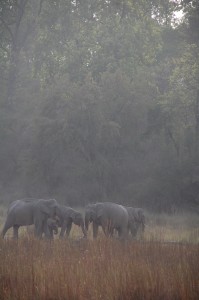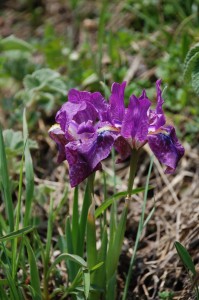Last week, we embarked on a journey to travel from our home base in Dehradun to the wilds of Rajaji National Park, then continued on to the Valley of Flowers, a UNESCO World Heritage Site near Joshimath.
Rajaji National Park is a very large reserve that is divided by highways, cities, and railways. Efforts to connect the park sections are evident as you drive through on the highway from the Dehradun airport, as you pass by a large overpass under construction. Upon completion, this overpass will reconnect to parts of the park and allow for more free movement of animals.
 We were invited to stay overnight at the researcher’s cabin in the Chilla section of the park, where tours are held to view wild elephants and other creatures. On our hour and a half long drive into the park, we saw a large group of elephants ripping up grass in the dry riverbed, spotted deer scampering through the open forest, and countless birds that I could not identify.
We were invited to stay overnight at the researcher’s cabin in the Chilla section of the park, where tours are held to view wild elephants and other creatures. On our hour and a half long drive into the park, we saw a large group of elephants ripping up grass in the dry riverbed, spotted deer scampering through the open forest, and countless birds that I could not identify.
The Chilla section of the park is remarkable for its animals, but also for its recent history. It is the only section of the park to have undergone a successful relocation of people living in the park. Once locals had been resettled elsewhere, the tiger population immediately began to rebound, doubling in about 4 years. The social implications of the relocation programs are quite serious and complex, changing for each family and in every park.
 After our visit to Rajaji Park, we headed to the mountains to see the Valley of Flowers, near Ghangaria in the Himalayas. Although it was early in the flowering season, and not many blossoms were showing yet, I was fascinated by the diversity and uniqueness of the flowers. Without much training in botany, I could only guess at the identity of the plants we saw, but many similarities to our alpine plants were present. Botanically speaking, one of the more interesting aspects to me was the composition of the forest, which is made up of mostly birch trees, right up to the tree line.
After our visit to Rajaji Park, we headed to the mountains to see the Valley of Flowers, near Ghangaria in the Himalayas. Although it was early in the flowering season, and not many blossoms were showing yet, I was fascinated by the diversity and uniqueness of the flowers. Without much training in botany, I could only guess at the identity of the plants we saw, but many similarities to our alpine plants were present. Botanically speaking, one of the more interesting aspects to me was the composition of the forest, which is made up of mostly birch trees, right up to the tree line.
I was also struck by the potential problems and an opportunity for research that Ghangaria water systems pose. This very popular and tiny town is host to hundreds of thousands of pilgrims every year, who come to visit the Sikh holy site of Hem Kund, as well as the visitors who are coming to see the Valley of Flowers. Add into the mix that there are horses for travelers, many porters and horse handlers, and locals who work in the hotels. The net result is a nightmare of town planning in a very small area, with no coordination between interested groups.
In an interesting mesh of hydrology, sociology, and civic planning, it would be wonderful to see an effort made to improve the lives of locals, stem the rampant (mis)use of the water supply, and implement a waste treatment plan. Currently, local porters live in the abject poverty of tin sheds, drinking from polluted streams, right alongside the horse stables and the relatively lavish hotels. Although there should be an ample source of drinking water from ground sources, it is currently undrinkable, owing to the lack of coordinated planning and callous pollution.
